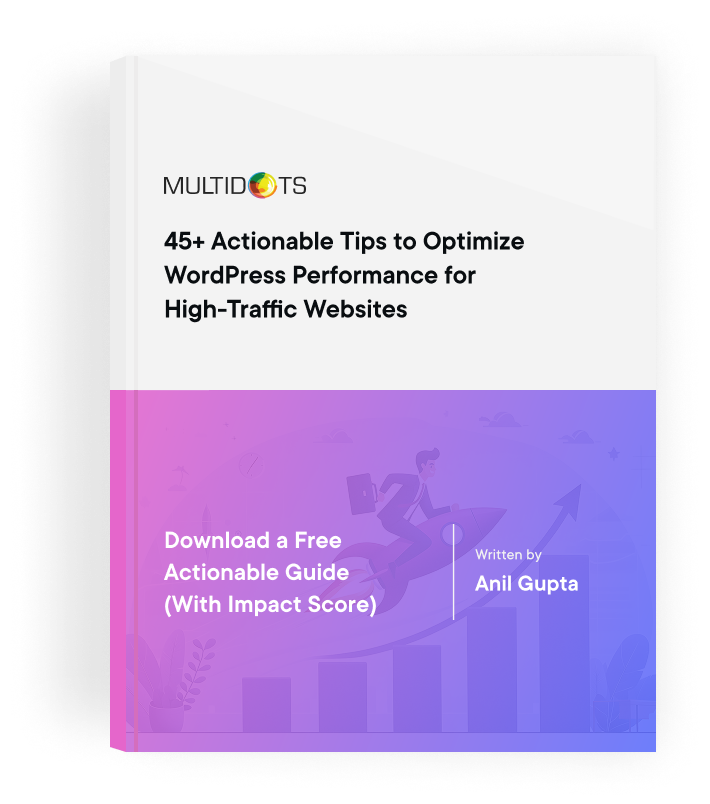Avoid Mistakes in Your Headless CMS Choice—Read Our In-Depth Comparison for the Best Decision
5 Popular Headless CMS Compared – Arc XP vs WordPress vs Sanity vs Contentful vs Sitecore
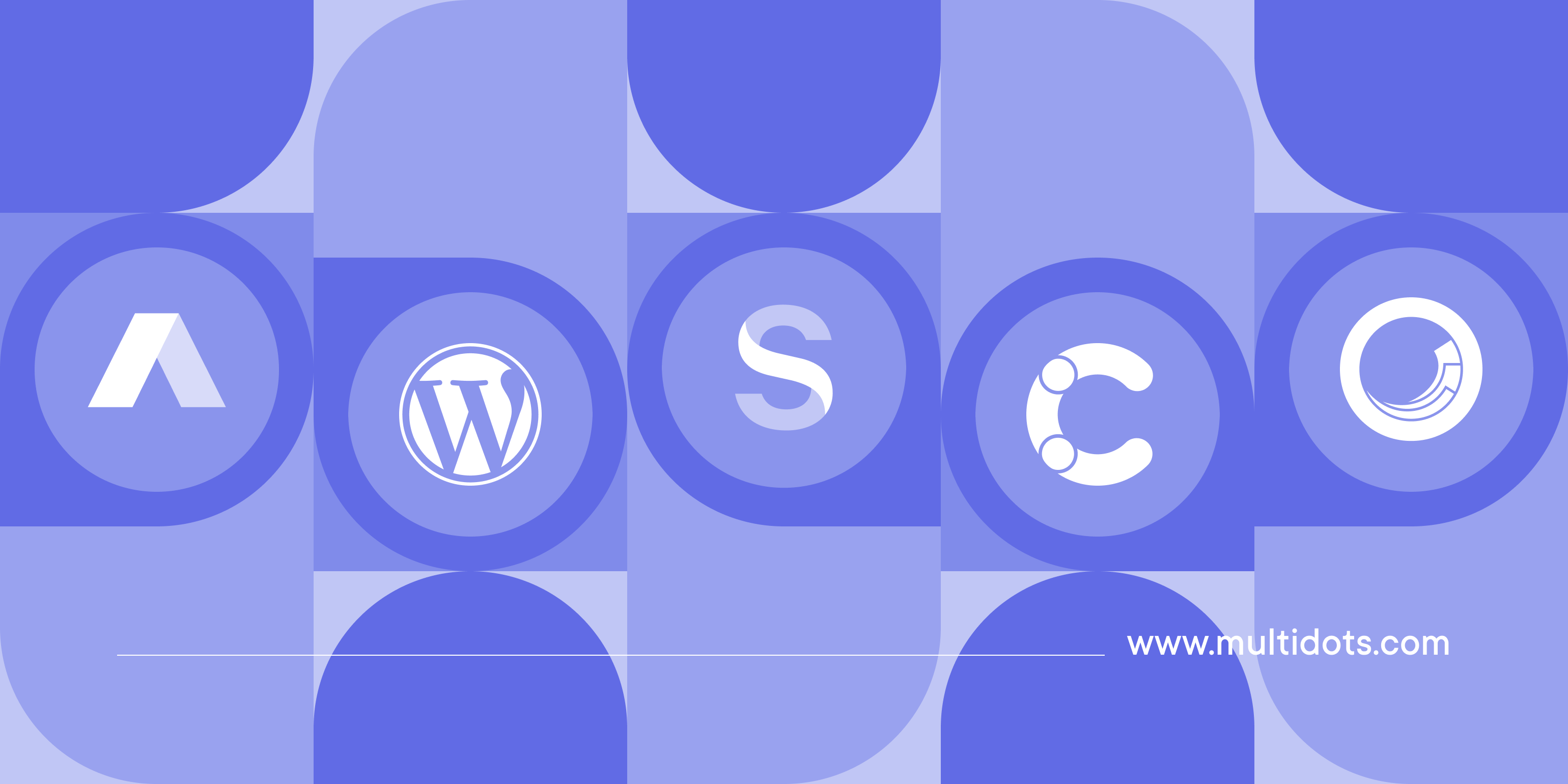
Table of Contents
The advancement in the CMSes has taken various directions in order for them to truly handle the demands of the modern web, they need to be scalable, with proper optimization and coupled with advanced security. Headless CMSes, a category of content management systems characterized by a decoupled backend and frontend, support various digital channels such as e-commerce, mobile apps, and digital signage.
Security is a big concern for businesses of all sizes, and there is no security solution that fits all the scenarios. As a business owner, one has to stay on top of security solutions employed on all layers of your operations.
For digital presences, Headless CMS is making waves because of its robust security, which is nearly impenetrable on the front end. Apart from security, headless solutions are known for scalability. Some headless CMSes also provide complete control to developers and teams, allowing for high customization, security, and flexibility.
Overview of Headless CMS: What is a Headless Architecture?
A headless CMS is a back end-only content management system that provides content through an API, decoupling the content repository from the presentation layer. This means that while the CMS manages and stores content, it does not dictate how that content is displayed on the front end.
Instead, developers can use various front end technologies to present the content across different channels, such as websites, mobile applications, and even IoT devices. Headless CMS platforms offer developers the flexibility to choose their preferred tech stack and modern tools, such as React or Vue, which enhances the overall developer experience by streamlining integration, data handling, and workflow.
This architecture allows for greater security, flexibility, scalability, and customization, making it an ideal choice for businesses to build their digital presence that is easy to manage and scale.
Benefits of a headless CMS
Selecting the right CMS is crucial for businesses aiming to create engaging and consistent digital experiences. The right CMS can streamline workflows, improve collaboration between teams, and ensure that content is delivered efficiently across various platforms and served to the audiences.
As organizations increasingly adopt omnichannel strategies, a headless CMS can serve as a central hub for content management, allowing for real-time updates and seamless integration with other tools and platforms.
- Improved Performance: Decoupling the front end from the back end results in faster load times and better overall site performance, as the content can be optimized specifically for each platform.
- Scalability: A headless CMS is highly scalable to handle high traffic on the front end while being integrated with various platforms, handling multiple operations seamlessly.
- Enhanced Security: Since the content management system and the presentation layer are separated, there’s an added layer of security. The headless structure limits potential entry points for attackers.
- Customization: Developers have more freedom to design the front end using any programming language or framework independently from the technologies used in the back end.
- Streamlined Development Process: A headless CMS supports a component-based architecture, which streamlines the development process by enabling efficient workflows and collaboration among development and content teams.
- Faster Time to Market: Content editors and developers can work independently without waiting for each other, speeding up development cycles and enabling faster content publishing.
- Enhanced Editing Experience: A well-designed editing experience in a headless CMS improves usability, collaboration, and workflow efficiency for content teams, making content management and localization easier.
- Future Proof: A headless CMS is future proof, ensuring adaptability to future technological changes and making it easier to implement new user interfaces or integrate with emerging platforms like AR, VR, or IoT devices.
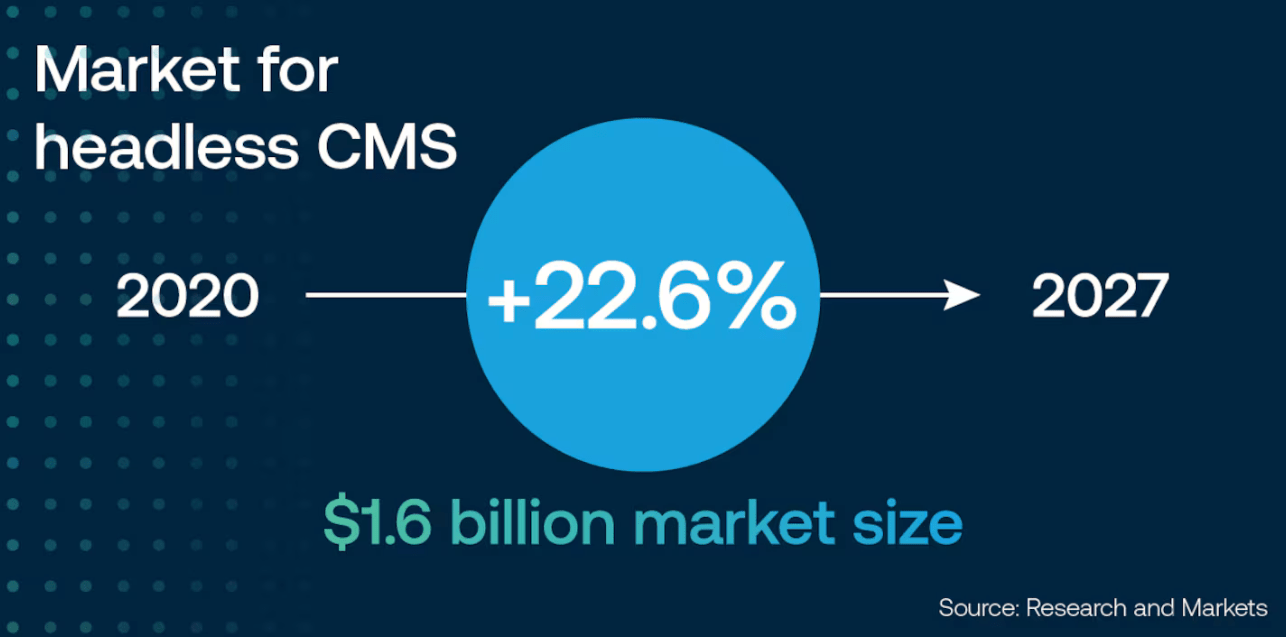
Market for Headless CMS
Types of Headless CMS
Headless CMS platforms come in several distinct types, each catering to different business needs and technical requirements. Understanding these categories can help you choose the right solution for your project:
- Open-source headless CMS: These platforms, such as Strapi, Payload, and Directus, provide complete access to their source code, allowing teams to customize and extend the CMS to fit unique workflows. Open source headless CMS options are ideal for organizations seeking flexibility, community support, and the ability to tailor their content management system to specific requirements. They are often highly customizable and can be self-hosted for greater control.
- Cloud-based headless CMS: Platforms like Contentful, Sanity, and Contentstack are hosted in the cloud, offering seamless scalability, robust security, and minimal maintenance overhead. These headless CMS platforms are designed for businesses that want to focus on content management without worrying about infrastructure. Cloud-based solutions often come with built-in features such as automated backups, global CDN, and easy integration with other services.
- Hybrid headless CMS: Hybrid platforms, including Magnolia and Agility CMS, blend the best of both worlds by supporting both traditional CMS and headless CMS capabilities. This means you can use a coupled presentation layer when needed, or opt for a decoupled architecture for more flexibility. Hybrid headless CMS platforms are perfect for organizations transitioning from traditional CMS to a more modern, API-driven approach.
- Specialized headless CMS: Some headless CMS platforms are purpose-built for specific use cases, such as e-commerce (Shopify), blogging (Ghost), or enterprise content management. These solutions offer tailored features and integrations that address the unique needs of their target industries, making content management more efficient and effective.
By understanding the different types of headless CMS, you can better evaluate which platform aligns with your content management goals, technical expertise, and long-term digital strategy.
Decoupled CMS: How It Differs from Headless
While both decoupled CMS and headless CMS move beyond the limitations of traditional CMS platforms, they differ in how they separate content management from content delivery.
A decoupled CMS features a backend for managing content and a separate, but still connected, frontend presentation layer. This means the CMS handles content creation and storage, while the presentation layer—often built with modern frameworks—displays the content. The two are linked, but updates to the frontend can be made independently of the backend.
In contrast, a headless CMS completely removes the presentation layer, delivering content solely via APIs (such as REST or GraphQL). This gives developers total freedom to use any frontend technology or framework, and to distribute content across multiple channels, devices, and platforms.
Key differences include:
- Presentation layer: Decoupled CMS retains a built-in presentation layer, while headless CMS offers none, relying entirely on APIs for content delivery.
- Flexibility: Headless CMS offers greater flexibility, allowing you to build custom frontends for web, mobile, IoT, and more, using your preferred tools and frameworks.
- Scalability: Headless CMS is typically more scalable, making it a better fit for complex projects that require omnichannel content delivery and integration with various platforms.
Choosing between a decoupled CMS and a headless CMS depends on your project’s complexity, need for flexibility, and long-term content management strategy.
Use Cases for Headless CMS
Headless CMS platforms are designed to meet the demands of modern digital experiences, making them suitable for a wide range of use cases:
- Multiple platforms: With a headless CMS, you can publish content seamlessly across multiple platforms, including websites, mobile apps, and IoT devices. This ensures a consistent brand experience, no matter where your audience interacts with your content.
- Static site generators: Headless CMS integrates effortlessly with static site generators like Gatsby, Next.js, and Hugo. This combination allows for lightning-fast, secure, and scalable websites, making it a popular choice for Jamstack sites and modern web development.
- Mobile apps: Managing content for mobile apps becomes straightforward with a headless CMS. Content teams can update and publish content in real time, while developers can deliver exactly the data needed to mobile devices through APIs.
- Omnichannel content delivery: Headless CMS platforms excel at omnichannel content delivery, enabling you to distribute content across multiple channels—web, mobile, smart devices, and more—from a single content repository.
- Enterprise content management: For large organizations with complex content needs, headless CMS offers the scalability, security, and flexibility required to manage content at scale. It supports advanced workflows, role-based permissions, and integration with other enterprise systems.
Whether you’re building a single page app, powering a global website, or managing content for various platforms, headless CMS platforms provide the tools and flexibility needed for modern content management and delivery.
Overview Arc XP, WordPress, Sanity, Contentful, SiteCore
When evaluating the best headless CMS platforms, it’s important to understand the unique strengths each brings to content management:
- Arc XP: This cloud-based headless CMS platform is designed for scalability, security, and ease of use, making it a strong choice for media organizations and enterprises. Arc XP offers advanced automation tools, robust analytics, and seamless integration with other platforms, supporting complex content operations.
- WordPress: As a widely adopted open source CMS, WordPress can be transformed into a headless CMS using plugins like WPGraphQL and WP REST API. This approach combines WordPress’s familiar, user friendly interface with the flexibility of decoupled architecture, allowing for real time collaboration and integration with modern frontend frameworks.
- Sanity: Sanity is a cloud-based headless CMS platform known for its real time collaboration, customizable workflows, and highly flexible content modeling. Its Sanity Studio provides a user friendly interface for content teams, while developers benefit from powerful APIs and automation tools.
- Contentful: Contentful stands out for its scalability, security, and comprehensive feature set, including advanced content modeling, automation tools, and seamless integration with other platforms. Its API-first approach and intuitive interface make it a favorite among developers and content teams alike.
- Sitecore: As a hybrid headless CMS platform, Sitecore offers both coupled and decoupled architecture, making it suitable for large, complex enterprise content management projects. Sitecore excels in personalization, automation, and integration with other enterprise systems, supporting sophisticated digital experiences.
Each of these headless CMS platforms offers a unique blend of features, making them suitable for different business needs, technical requirements, and content management strategies.
Let’s take a look at five headless CMS platforms, examine their individual features and strengths, and explore the specific use cases they are best suited for. These platforms offer many features, with some providing standout features and specific features tailored to unique use cases.
1. Arc XP
Arc XP is a headless CMS designed for media and publishing organizations. It offers robust content management capabilities and integration options that cater to the needs of modern digital teams.
Arc XP is a powerful headless CMS developed by the Washington Post, tailored for the media and publishing industries. It provides a comprehensive suite of tools designed to streamline content creation, management, and distribution.
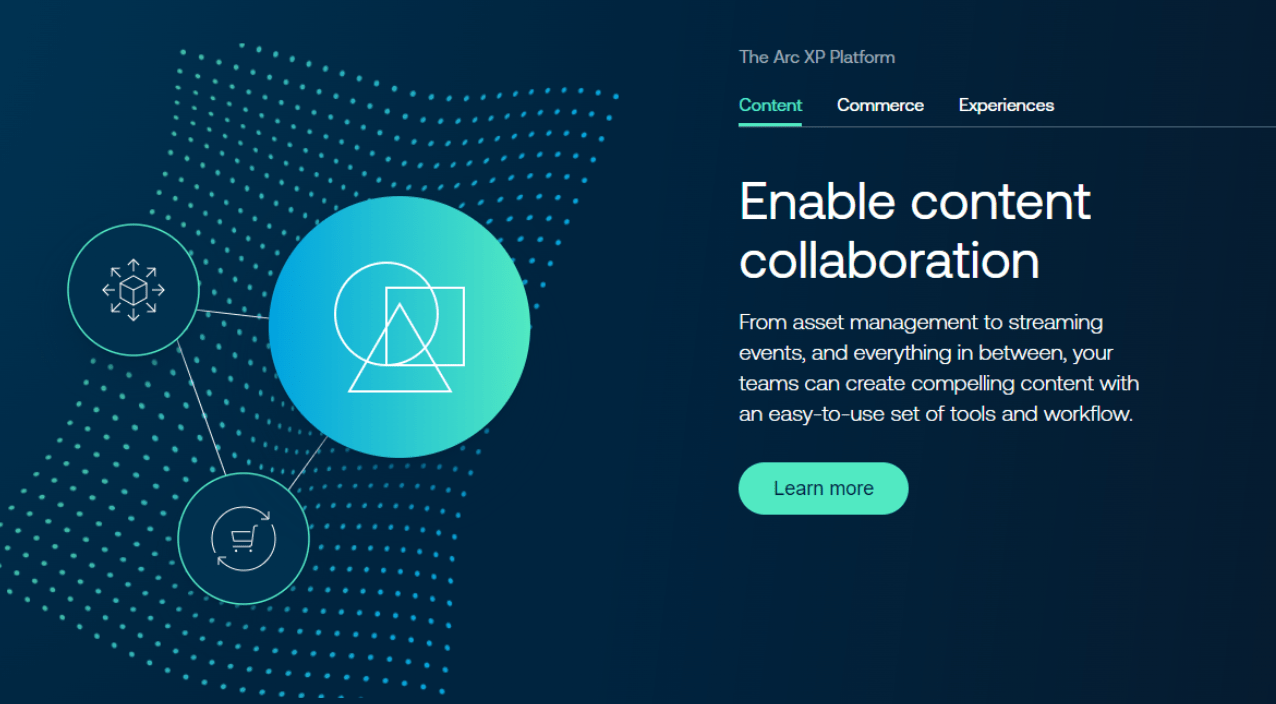
Arc XP Headless CMS
Key Features
- Content management capabilities: Arc XP offers robust content management features, allowing teams to create, edit, and publish content efficiently.
- Integration options: The platform supports various integrations with third-party tools, enhancing its functionality and adaptability.
- Performance metrics: Arc XP provides analytics and performance metrics to help organizations measure the effectiveness of their content strategies.
| Pros | Cons |
|---|---|
| Scalable Cloud-Based Infrastructure | High Cost |
| Omnichannel Publishing | Complex Setup |
| Integrated Digital Experience | Limited Customization for Smaller Projects |
| Customizable and Flexible | Dependence on Cloud Infrastructure |
| User-Friendly Interface | Learning Curve for Advanced Features |
| Built-in Analytics and Personalization | |
| SEO and Speed Optimization |
Arc XP is best used for:
- Media and Publishing Companies
- Enterprises Needing Personalized Digital Experiences
- Government and Non-Profit Organizations
- Multi-national corporations (MNCs) with Global Operations
2. Sanity
Sanity is a developer-friendly headless CMS that emphasises real-time collaborative editing and structured content management. Sanity supports flexible content structures, enabling complex relationships, localization, and scalable content modeling for large-scale and multilingual websites. It is particularly well-suited for teams looking to create dynamic and interactive content experiences.
Sanity calls itself the Content Operating System, featuring the most flexible content workspace, Sanity Studio provides content creators with a modern and easy way to produce content at scale.
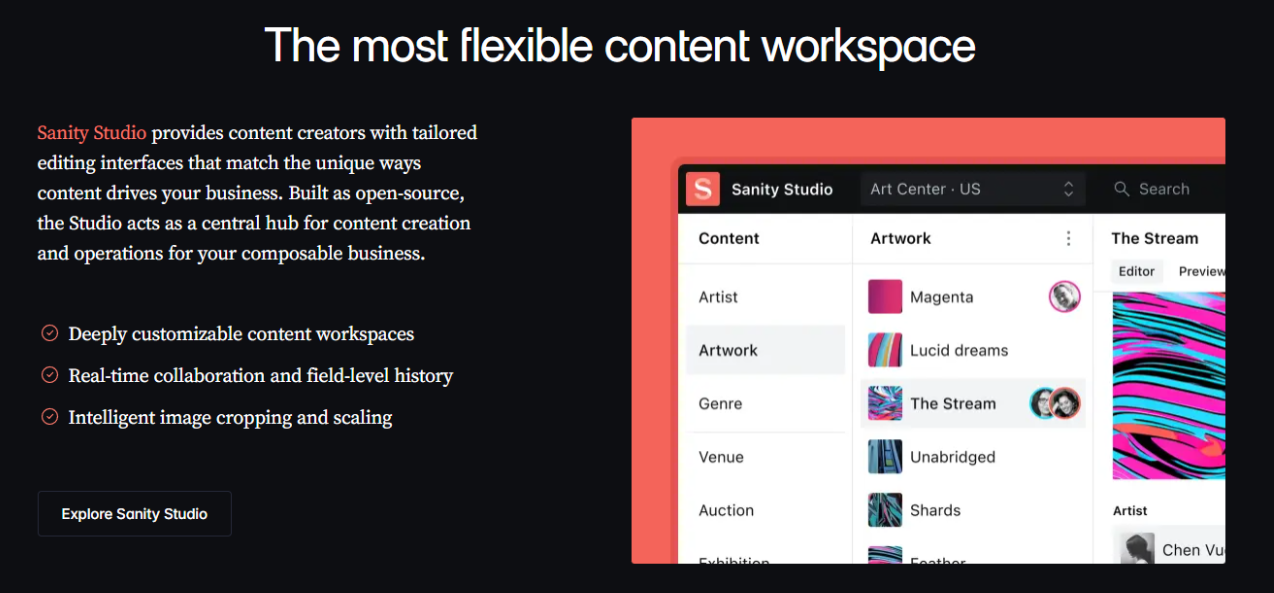
Sanity Headless CMS with Sanity Studio
Key Features
- Real-time editing: Sanity provides real-time collaboration features that allow teams to work together on content simultaneously, with live updates and editing capabilities.
- Structured Content: It is built around the idea of structured content, where content is stored as data objects. This allows users to easily reuse and repurpose content across different channels.
- API-first approach: Sanity’s API-first design enables seamless integration with various front end technologies.
- Customizable Content Studio: Sanity offers a highly customizable user interface called the Sanity Studio. Developers can tailor the studio to fit specific workflows, making it easier for content creators to manage and update content.
- Asset Management: It offers tools to manage images, files, and other digital assets, with image transformation and optimization capabilities built-in
| Pros | Cons |
|---|---|
| Highly customizable and developer-friendly | Requires development expertise for customization |
| Real-time collaboration features for teams | Learning curve for non-technical users |
| Scalable for both small and enterprise projects | |
| Strong asset management and API capabilities |
Sanity CMS is best used for:
- Media and Publishing
- Marketing Websites
- Applications with Dynamic Content
3. Contentful
Contentful is a cloud-based headless CMS designed to support scalable, personalized digital experiences. It excels in content modeling and API capabilities, making it a strong choice for developers and content teams alike.
With built-in tools such as the Contentful platform and Contentful Studio, publication teams can easily create, manage, and publish content at scale. Contentful's API-first architecture enables seamless integration with other systems, enhancing interoperability and flexibility across different platforms and workflows.
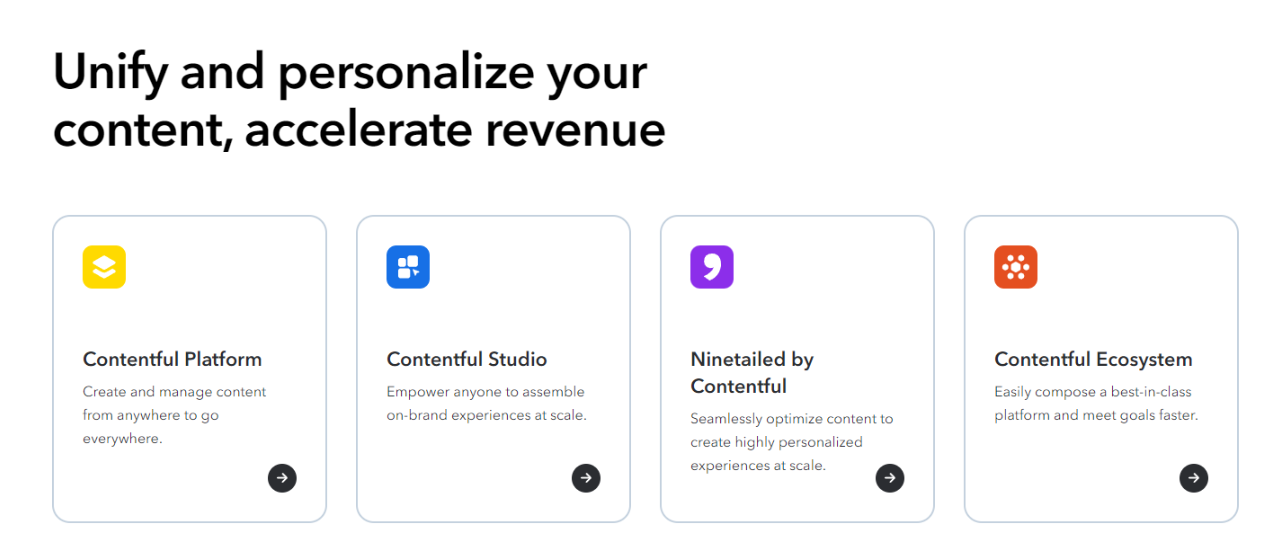
Contentful Headless CMS Top Features
API-First Approach: Contentful offers both REST and GraphQL APIs for efficient content retrieval and integration, providing speed, robust documentation, and ease of use for content management and real-time collaboration workflows.
Key Features
- Content modeling: It offers flexible content modeling, where users can define custom content types, fields, and relationships, making it easier to structure content.
- Versioning and Workflow Management: Contentful offers version control, enabling users to track changes, revert to previous versions, and manage publication workflows with custom roles and permissions.
- Performance and scalability: Contentful is designed to handle high traffic and large content volumes, making it suitable for enterprise applications.
- API-First Approach: Contentful is built with an API-first approach, offering powerful RESTful and GraphQL APIs. This makes retrieving and managing content programmatically and integrating it with other services is easy.
- Asset Management: Built-in digital asset management (DAM) tools allow users to upload, organize, and optimize media assets like images, videos, and documents.
| Pros | Cons |
|---|---|
| Flexible content modeling and API-driven | Requires development expertise for setup and customization |
| Scalable for small to enterprise projects | Can become expensive at scale |
| Strong support for multi-platform content delivery | Limited built-in features for non-developers |
| Robust collaboration and role management | Content previews can be challenging to configure |
Contentful is best used for:
- E-commerce Platforms
- Media and Publishing
- Marketing Websites
- Mobile and Web Applications
- Multilingual Content Delivery
4. Sitecore
Sitecore positions itself as the "only complete, composable, cloud-native digital experience platform." It is a sophisticated headless CMS designed to empower organizations with a flexible and efficient content management solution. It enables businesses to manage and deliver content across multiple channels and devices without being tied to a specific presentation layer.
Sitecore enables businesses to create modern digital experiences with integrated content distribution and e-commerce capabilities. While Sitecore is ideal for large enterprises and complex projects, it may be more than necessary for small businesses, and is best suited for mid sized businesses and above.

Sitecore Headless CMS Capabilities
Key Features
- Decoupled Architecture: Sitecore's headless CMS separates content management from content delivery, allowing developers to use APIs to fetch and present content in various formats, such as JSON and XML.
- Content Reusability: The platform allows content to be reused across different channels.
- Experience Platform (XP): Offers personalized customer experiences across all touchpoints, integrating content management, customer data, and analytics.
- E-commerce Integration: Built-in tools for managing and optimizing e-commerce experiences, including product catalogs, personalization, and conversion tracking.
- Personalization: Advanced AI-driven personalization for delivering relevant content based on user behavior, preferences, and demographics.
- Integration with Third-Party Tools: Seamlessly integrates with popular CRM, ERP, and marketing tools like Salesforce, Microsoft Dynamics, and more.
- Personalization and SEO Optimization: Sitecore excels in delivering personalised content experiences and provides tools for meticulous control over SEO elements, enhancing visibility and search engine rankings.
| Pros | Cons |
|---|---|
| Comprehensive digital experience platform | High licensing costs for smaller businesses |
| Advanced personalization and AI-driven features | Requires development expertise and ongoing maintenance |
| Strong third-party integration options | Steep learning curve for non-technical users |
| Scalable for enterprise projects with multisite support | Complex setup and configuration can be time-consuming |
Sitecore is best used for:
- Enterprise-Level Websites
- E-commerce Platforms
- Large-Scale Multisite and Multilingual Projects
5. Headless WordPress
WordPress has gained significant traction in the headless CMS space, thanks to numerous companies investing time and resources to configure it as a back end content management system. This setup allows WordPress to work seamlessly with various front-end technologies to create dynamic and flexible presentation layers. In contrast, traditional CMS platforms often rely on rigid templates, which can limit flexibility and slow down content updates.
The primary advantage of using WordPress as a headless CMS is the ability to leverage its mature and robust plugins, which enhance accessibility, add features, and facilitate scalable operations for content publishing platforms. WordPress and other headless CMS platforms also support reusable content blocks, enabling efficient management and consistent deployment of modular content across multiple pages or projects.
WordPress’s flexibility as a headless CMS allows large enterprise organizations to power their content experiences with a well-maintained, open-source CMS. For those seeking alternatives, Payload CMS is a top open-source headless CMS suitable for a JavaScript/Node.js stack, Netlify CMS is an open-source content management system designed for static site generators and modern JAMstack projects, and Strapi Cloud offers a fully managed, scalable headless CMS solution for cloud-based deployments.
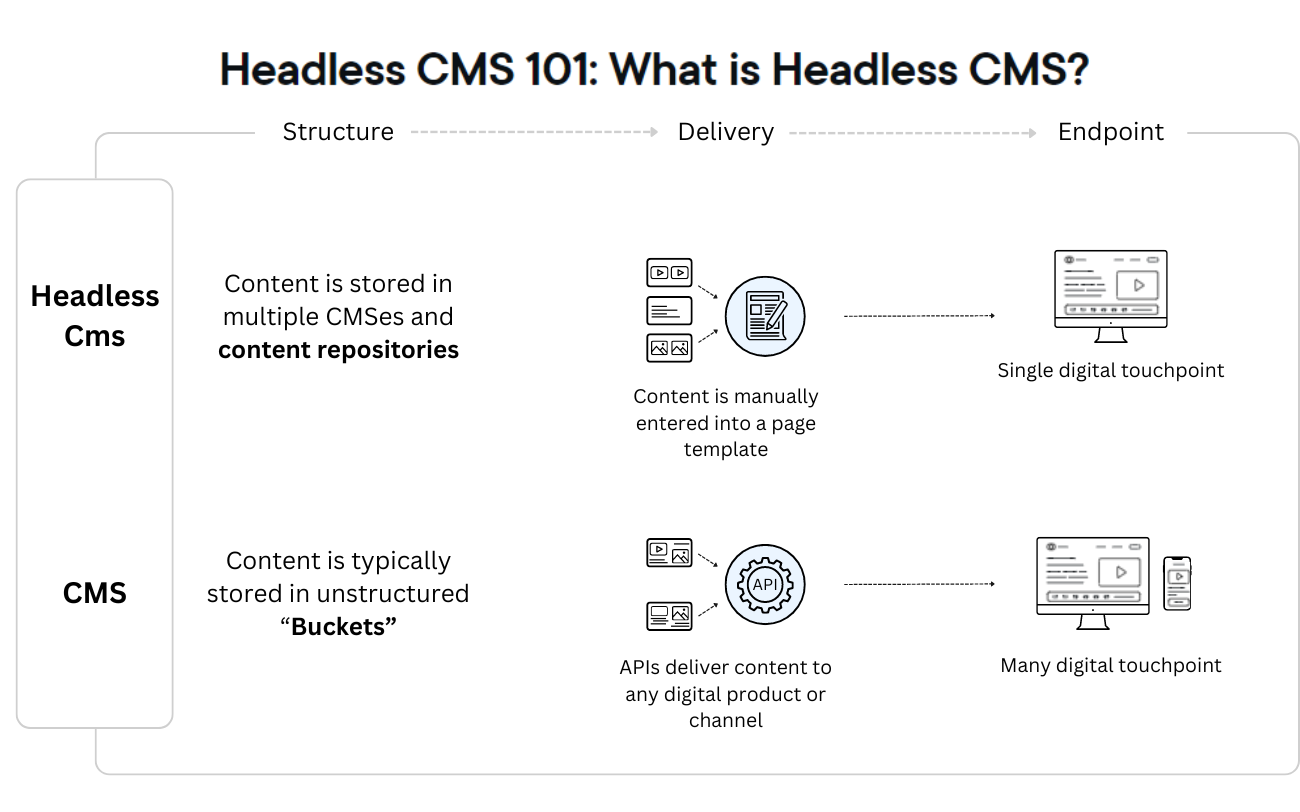
Headless CMS explained by Multidots
Key Features
- REST API: WordPress offers a REST API to access and manage content. This allows for flexible content delivery to various front end applications.
- Content Management Interface: The familiar WordPress admin interface allows content creators and editors to manage content efficiently, even when the presentation layer is decoupled.
- Media Management: WordPress's media library facilitates the management of images, videos, and other media assets, which can be accessed via the API.
- Content Scheduling and Revisions: WordPress supports scheduling posts and managing revisions, ensuring content updates are controlled and tracked.
- User Management and Permissions: WordPress provides built-in user roles and permissions, which can be used to control access to content and features within the CMS.
- Unmatched Plugin Ecosystem: WordPress's extensive library of plugins can be used to enhance functionality, manage SEO, add analytics, and more, even in a headless setup.
- Resource Efficient: WordPress is designed to use minimal server resources, with a core optimized for performance. This efficiency contributes to its scalability, making it suitable for handling high traffic websites and applications.
| Pros | Cons |
|---|---|
| Allows content to be delivered to any device or platform, enhancing multi-channel publishing capabilities. | Significant technical knowledge is needed to set up and maintain the system, which may necessitate hiring skilled developers. |
| Decoupling the front end from the back end can lead to faster loading times and improved site speed. | Managing separate back-end and front-end systems increases complexity and maintenance efforts. |
| Developers can create unique user experiences without being restricted by WordPress themes. | |
| The separation of the front-end and back-end reduces vulnerability to attacks. | |
| Content management and publication experience are the same as traditional WordPress. | |
| Adapting to new technologies becomes easier, allowing for long-term flexibility and updates. |
Headless WordPress is best used for:
- E-commerce Platforms
- Large-Scale Multisite Projects
- Enterprise Content & Media Websites
- Corporate businesses
Content Management Capabilities
Modern headless CMS platforms are packed with powerful content management capabilities designed to streamline workflows and enhance collaboration:
- Content modeling: Easily create custom content models and structures to organize content exactly as your project requires. This flexibility supports a wide range of content types and relationships.
- Content editing: Benefit from a user friendly interface that allows content teams to create, edit, and manage content efficiently, often with real time collaboration and visual editing tools.
- Content repository: Store and manage all your digital assets and structured content in a centralized, secure content repository, ensuring consistency and easy access across your organization.
- Version control: Track changes, manage revisions, and revert to previous versions of content, providing transparency and control over your content lifecycle.
- Workflow management: Set up custom workflows and approval processes to streamline content creation, review, and publishing, ensuring quality and compliance.
- Collaboration tools: Leverage real time collaboration, commenting, and role based permissions to enable content teams to work together seamlessly, regardless of location.
- Integration with other platforms: Connect your headless CMS with marketing automation, e-commerce, analytics, and other platforms to create a unified digital ecosystem.
- Security and scalability: Enjoy enterprise-grade security features, including role based permissions, automated backups, and robust scalability to support growing content needs and traffic spikes.
These capabilities make headless CMS platforms a powerful choice for managing content efficiently, supporting complex projects, and enabling teams to deliver engaging digital experiences across multiple channels.
Quick Comparative Analysis
| Feature/Aspect | Arc XP | WordPress | Sanity | Contentful | Sitecore |
|---|---|---|---|---|---|
| Target Audience | Enterprises and media companies | Bloggers, small to large businesses | Developers and content teams | Developers, marketers, and enterprises | Large enterprises and complex projects |
| Content Management | Advanced, with a focus on media | User-friendly with a variety of plugins | Real-time collaboration, customizable editor | API-first, flexible content modeling | Comprehensive with strong workflows |
| Integration Options | Extensive API support | Wide range of plugins and REST API | RESTful and GraphQL APIs | API support with third-party integrations | Extensive integration capabilities with API |
| Performance | High scalability for media | Varies based on hosting | Highly scalable with real-time updates | High performance with CDN support | High performance for large-scale applications |
| Customization | Flexible, tailored solutions | Highly customizable with full access to files | Highly customizable editor interface | Custom content types and extensions | Extensive customization options |
| Learning Curve | Moderate to high | Low to moderate | Moderate | Moderate | High |
| Pricing Structure | Custom pricing based on usage | Free with premium options | Custom pricing based on usage | Tiered pricing based on features | Custom pricing based on enterprise needs |
| User Experience | Designed for technical users | User-friendly for all levels | Developer-focused but user-friendly | Intuitive for non-technical users | Complex, tailored for enterprise needs |
| Omnichannel Delivery | Strong support for multiple channels | Good, needs customization. | Excellent for various platforms | Excellent for multiple devices | Strong omnichannel capabilities |
| Collaboration Features | Advanced collaboration tools | Basic collaboration features that can be enhanced | Real-time collaboration | Role-based access control | Advanced workflow and collaboration tools |
Which Headless CMS Is Right for You?
The headless CMS market has evolved significantly, with platforms continually improving across various dimensions. These decoupled architecture CMS solutions are particularly well-suited for building modern digital experiences and meeting enterprise needs.
Choosing the right headless CMS depends on your team’s skills and future scalability considerations. Businesses should plan ahead and evaluate the costs associated with scaling content operations and the complexity of the platform. Some headless CMS platforms also offer a visual editor, which can improve usability, real-time editing, and collaboration for content teams.
Arc XP, Sanity, Contentful, and Sitecore are core headless platforms, each with its own system and supported integrations. While customization is possible, it often requires developers with specialized skills.
In contrast, WordPress can be configured as a headless CMS, even though it is not headless by default. The primary advantages of using headless WordPress include its extensive customizability, plugins, and lower initial costs.
As a WordPress VIP Gold partner, Multidots has extensive experience helping enterprise organizations transition to WordPress and scale their content operations. Contact our team today to book a free consultation and learn how we can support your business’s growth.
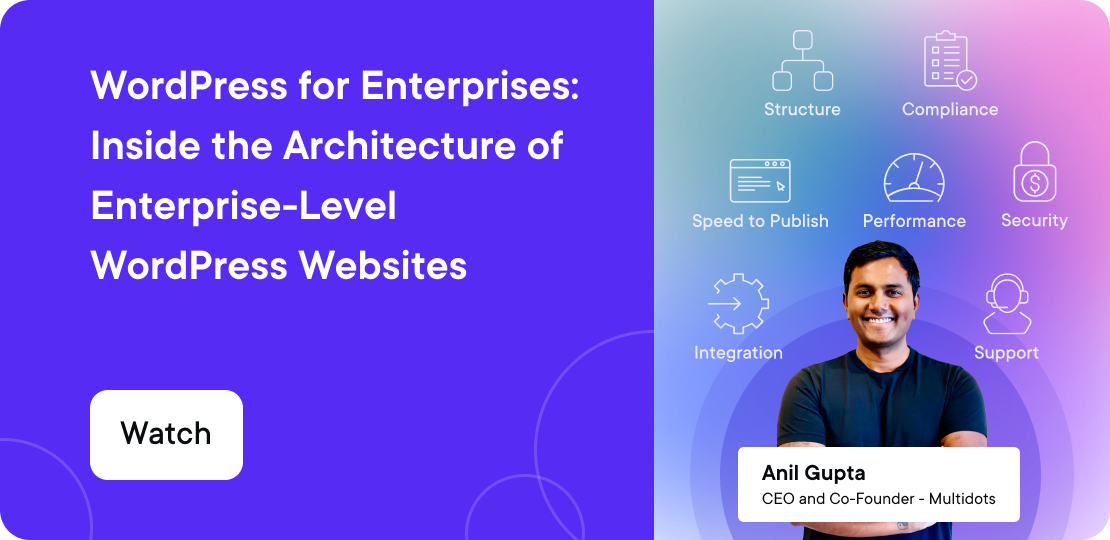
Schedule a consultation call and discuss your migration requirements.
Contact Us